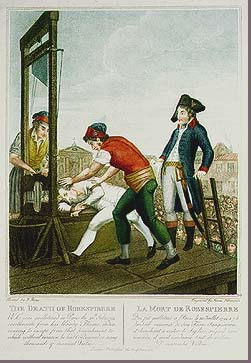 |
II. The Logic of the Terror A. Institutions, Phases, Numbers: The Terror in Outline (April 1793-July 1794) B. The Terror as a System of Goverment: The Logic of Totality Image: The Committee for Public Safety
at Work (1793) III. Republican Transformations Image: The Revolutionary Calendar Image left: The Death of Robespierre. This engraving, based on a color portrait by Beys, depicts the death of Robespierre on the guillotine. The executioners wear not the traditional hangman’s hood but red bonnets representing liberty. This judgment notes Robespierre’s failure to the Revolution itself. Contemporaries emphasized that Robespierre’s punishment was just because it was the same to which "he had condemned so many thousands of innocent victims." |
.jpg)